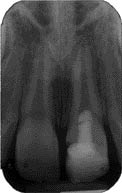(b) 
Diagnosis and treatment planning
The tooth appeared to be vital with incomplete root formation.
The only viable treatment option that should be discussed with the patient’s mother is apexogenesis.
What is the rationale for apexogenesis?
The aim of the treatment is to remove inflamed and/or superficially necrotic pulp tissue, and place a dental restorative material which is biocompatible and prevents microleakage, over the remaining vital (uninflammed) pulp tissue to promote further root development.
Treatment
Local anaesthetic was administered and rubber dam applied to the tooth. The existing restoration was removed to reveal that the pulp stump was only partially pulp-capped. On removing the pulp capping material, the pulp stump started to bleed. Two millimetres of coronal pulp tissue was amputated with a long taper diamond bur in an air turbine handpiece using water coolant. The wound site was then gently rinsed with sodium hypochlorite; a cotton pellet moistened with saline was gently placed over the exposed pulp stump for several minutes in an attempt to arrest bleeding. However, haemostasis could not be achieved indicating the pulp tissue was still inflamed; the pulp was then amputated using the same technique to the cemento–enamel junction to ensure that the inflamed portion of the pulp had been completely removed. The wound site was gently rinsed with sodium hypochlorite and a moist cotton pellet was placed again over the pulp wound; this time haemostasis was achieved (Box 3.2.1).
Box 3.2.1 Factors required for successful apexogenesis
- Pulp is not irreversibly inflamed.
- Haemostasis of the pulp wound.
- No clot formation between the pulp wound and the pulp capping/pulpotomy material.
- Well adapted pulp capping/pulpotomy seal and coronal seal to reduce the likelihood of microleakage.
Mineral trioxide aggregate (MTA) was placed over the pulp stump; a flowable composite resin restoration was used to seal the MTA into place (Figure 3.2.1b). The tooth was then restored with a composite resin restoration.
What advice should you give the patient and her mother?
- Regular review appointments are necessary to assess the outcome of treatment.
- It is essential to use a custom-made mouthguard for all contact sports.
- To return as soon as practicably possible should any symptoms develop.
Stay updated, free dental videos. Join our Telegram channel

VIDEdental - Online dental courses


